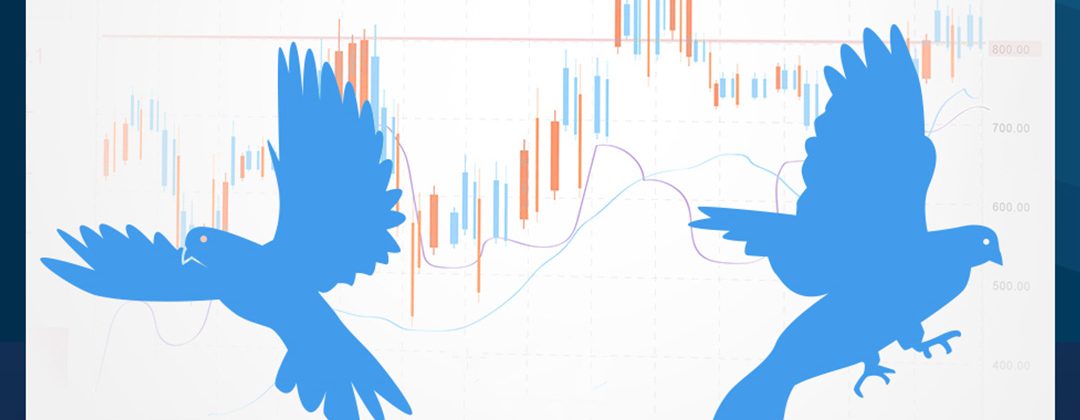Central banks play a crucial role in keeping inflation in check for their respective nations, while ensuring continued economic growth. Hawkish and dovish policies allow them to perform their duties effectively. Read on to learn why keeping an eye on these policy stances is essential and how to refine your trading strategy with the changing stance of central banks.
Hawkish vs Dovish Policies
Also known as monetary tightening, a hawkish stance entails raising repo rates to curb inflation. Just like a hawk that keeps its eye on its prey, when the central bank of a country is laser-focused on bringing inflation down, it opts for a hawkish policy. The central bank raises the rate at which it lends to standard banks, and, hence, the rates at which these banks lend to customers. Elevated rates suppress credit demand and reduce economic activity, which eventually translates into cooling inflation down.
A dovish stance, on the other hand, is that of monetary easing. Central banks stimulate economic activity by lowering interest rates, even bringing them down to zero. By simplifying access to capital, central banks bolster market liquidity, stimulating expenditure, and, hence, economic activity. This is used in a deflationary economic environment to bring inflation up to the desired level.
Impact of the Central Bank Stance on Major Currency Pairs
The goal of a central bank’s interest rate hikes is to lower inflation. This tends to lead to softening economic activity and weakening of the job market. However, the immediate impact is on the domestic currency.
Higher interest rates attract foreign investment to the country. The increased demand for the home currency lifts its valuation. Forex traders watch interest rate updates and consensus expectations to factor in interest rate changes (or no change) in their FX trading strategies.
The inverse relationship between interest rates and currency valuation is evident in the pound sterling’s 2023 performance. Although the Fed, BoE and ECB all raised interest rates in the first three quarters of 2023, the Bank of England’s policy exceeded analyst expectations, when the rates were raised to 5.5%. Consequently, the GBP hit a 15-month high in July 2023 and ended the year gaining almost 5% against the USD. It was the second best-performing currency in the foreign exchange market among the G10 countries.
By the end of February 2024, annual food inflation in the UK has slowed to 5%, from 6.1% in January, reaching the lowest rate since May 2022. Additionally, core inflation, the BoE’s primary parametre to make interest rate decisions, dropped to 5.1% in January 2024. Declining inflation tends to be accompanied by economic growth, which remained flat in January. This indicates that BoE might soon take on a dovish stance.
Impact of Interest Rate Hikes on Precious Metal Prices
Since commodities are majorly traded in USD, the interest rate policies of the Federal Reserve significantly affect the commodity markets. Purchasing oil, food and precious metals becomes costlier for other nations. This results in a decline in demand and hence prices.
However, gold being a safe haven asset, often continues to see high demand amid economic uncertainties. Additionally, numerous other factors play a role in gold prices than just interest rates. For instance, gold ended 2023 13% higher from where it started the year. This was due to heightened geopolitical tensions, a sustained higher-for-longer stance by the Fed, and demand from global central banks.
The good news is that market sentiment works based on expectations. For instance, in February 2024, gold price rose as speculators hoped the Fed would cut interest rates. But the shiny metal pared its gains as soon as the US NFP report was out, highlighting that a resilient job market may force the Fed to maintain its higher-for-longer stance. Short- and medium-term traders exploit such volatility to maximise earnings.
Analysts expect gold price to rise 10% by the end of December 2024 if the Fed cuts interest rates in the second half of 2024. However, the geopolitical atmosphere and subdued global growth are likely to induce volatility, generating a plethora of opportunities for traders. Therefore, make sure to consider market sentiment along with technical analysis to make informed decisions.
Taking Advantage of Central Bank Policies
Traders can participate in the foreign exchange market via derivative instruments, such as CFDs. These are leveraged instruments traded using margin. They allow traders to take advantage of both rising and falling prices, making CFDs an effective way to hedge your positions. You can also use a forex leverage calculator to size your positions optimally. However, margin trading magnifies both profit and loss potential, necessitating robust risk management with stop loss, take profit, and other measures.
To Sum Up
- Hawkish central bank policy means it is inclined to raise interest rates to curtail inflation.
- Dovish central bank policies result in interest rate cuts.
- Interest rate hikes have a direct correlation with major currency prices.
- Interest rate hikes have an indirect correlation with commodity markets, such as gold.
- Traders popularly trade forex and gold via CFDs to speculate on both rising and falling prices.
Disclaimer
All data, information and materials are published and provided “as is” solely for informational purposes only, and is not intended nor should be considered, in any way, as investment advice, recommendations, and/or suggestions for performing any actions with financial instruments. The information and opinions presented do not take into account any particular individual’s investment objectives, financial situation or needs, and hence does not constitute as an advice or a recommendation with respect to any investment product. All investors should seek advice from certified financial advisors based on their unique situation before making any investment decisions in accordance to their personal risk appetite. Blackwell Global endeavours to ensure that the information provided is complete and correct, but make no representation as to the actuality, accuracy or completeness of the information. Information, data and opinions may change without notice and Blackwell Global is not obliged to update on the changes. The opinions and views expressed are solely those of the authors and analysts and do not necessarily represent that of Blackwell Global or its management, shareholders, and affiliates. Any projections or views of the market provided may not prove to be accurate. Past performance is not necessarily an indicative of future performance. Blackwell Global assumes no liability for any loss arising directly or indirectly from use of or reliance on such information here in contained. Reproduction of this information, in whole or in part, is not permitted.





